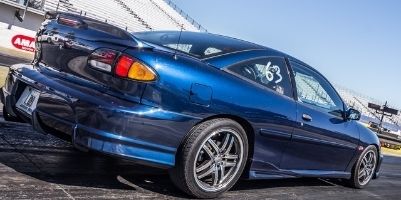Do Flex-Fuel vehicles trim fuel differently?
The stoichiometry of ethanol requires more fuel for the same amount of air than does gasoline. As you
add small amounts of ethanol to the fuel, like with E10, your ECM will make positive trim adjustments to
correct the fuel to air mixture. As higher ethanol concentrations are used, higher levels of additional
positive trim will be needed. Non Flex-Fuel vehicles will generally reach their capacity for positive trim
with a concentration of approximately 50% ethanol. Afactory Flex-Fuel vehicle will have an ECM which
has the necessary capacity for positive trim to correctly trim the fuel for high concentrations of ethanol.
What does stoichiometry mean?
The stoichiometry of a fuel refers to the coefficients in the chemical reaction equation and is expressed
as a ratio of the mass of air to the mass of fuel. For pure octane, the ratio is about 14.7:1, but do you
know anyone who burns pure octane in their car? Gasoline is a mixture of many different compounds,
most of which are usually not octane but various alkenes. Each of these compounds will have a
different stoichiometric ratio and the exact chemical makeup of gasoline can vary quite a lot from one
tankful to the next. The air available can, and does, change as we drive to different altitudes, the
temperature changes, and even from moment to moment due to wind pressure. It could be terribly
complex to compute the exact mixture needed for each tank of fuel, but a modern ECM will use a fuel
trim system to make the mixture more lean (negative trim) or more rich (positive trim) to compensate for
different operating conditions.
How does our converter work?
Our converter works in concert with your vehicle's fuel trim system. Flex-fuel vehicles have a fuel trim
system with more capacity for positive trim than the positive trim capacity in a non flex-fuel vehicle. By
inserting a digital signal processor and some electronics between the ECM and the injectors, we can
add some positive trim to help the non flex-fuel vehicle reach the amount of positive trim necessary for
correctly using ethanol. This added trim, combined with what the ECM can provide, allows the ECM to
trim the fuel to reach the proper mixture for E85. Our converter has an internal adjustment which allows
it to be tuned to each vehicle and the range of fuels typically being used. We have found that a setting
of about 60% of the converter's positive trim works very well for the vast majority of vehicles and ship
converters set to this level.
Do you tap into or modify the signal from any of the sensors?
Absolutely not! We do not modify, disconnect, alter, or otherwise interfere with any sensor. We also do
not interrupt, sample, intercept, reformulate, or otherwise adulterate the signal from any sensor.
Our converter takes a completely hands-off approach to the sensors, their signals, and the operation of
the ECM. We ONLY modify the injector pulse and leave the sensors completely AS IS. The sensors and
the ability for the ECM to accurately monitor the conditions they are designed to sense form the heart
of a vehicle's emission control system. Any adulteration in the integrity of the sensor signals would
interfere with the ability for the ECM to receive proper inputs and, in essence, would be an engineering
change to the emission control system with which the vehicle originally certified. Even tapping into a
signal could theoretically cause some unexpected interference. By not messing with any of the vehicle's
sensors, we eliminate the risk of disrupting the ability for the ECM to get accurate information with which
to properly run the emission control equipment. The on-board diagnostics that have been required
since 1996 will detect if the emission control equipment is not operating within acceptable parameters.
As long as the ECM has unadulterated signals from its sensors, the emission control equipment will
either be operating correctly or a check-engine condition will occur. For most modern vehicles, the only
thing they lack to be able to use ethanol is a bit of a boost to the amount of positive trim they can
produce. That can easily be done by making a small increase in the injector pulse width. This makes for
a very clean conversion and leaves your vehicle's emission control unaltered.

It's nice to be injected but I love being blown.















